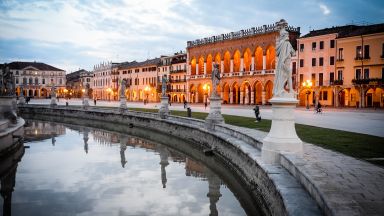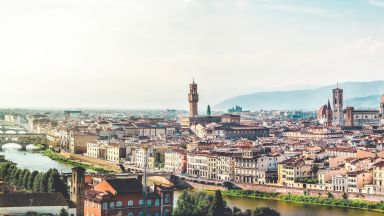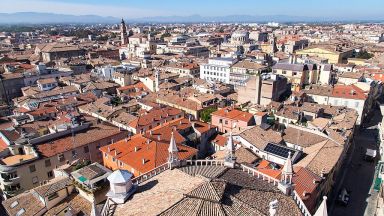Padova: The Complete Guide
Padova or in English Padua is a city in North Eastern Italy, and the capital of the province of the same name. It is located centrally in the Veneto region, between Venice on one side and Venice on the other.
Famous as the backdrop for Shakespeare’s “The Taming of the Shrew,” Padua is particularly distinguished for its 14th-century Scrovegni Chapel adorned with emotionally resonant frescoes by Giotto. Another notable feature is the expansive Prato della Valle, Italy’s largest square. Established in 1222, Padua University stands as one of the world’s oldest and holds a revered status among scholars as the birthplace of modern medicine.
Visiting Padova for the first time and wondering what are the top places to see in the city? In this complete guide, I share the best things to do in Padova on the first visit. Top help you plan your trip, I have also included an interactive map and practical tips for visiting!
This website uses affiliate links which earn a small commission at no additional cost to you.
History of Padova
Legend has it that Padua, one of the oldest cities in Northern Italy, was founded in the 12th century BC by Antenor, a Trojan hero and advisor. In the 11th century, the citizens of Padua crafted a constitution and elected their own governor. The city experienced a period of relative peace and prosperity until the 13th century when notable landmarks such as the Basilica di San Antonio and one of the world’s oldest universities were established.
Throughout its history, Padua has been associated with distinguished individuals, including the renowned poet Dante in the 14th century and Galileo Galilei, who served as a professor at the university from 1592 to 1610. Governance shifted to the Carrara family from 1318 to 1405, after which Padua became a part of the Venetian Republic. Under Venetian rule, the city underwent fortification with new walls and the construction of six monumental gateways that still stand today. The university, during this time, emerged as the primary educational hub of the Republic, reflecting its commitment to promoting a renowned institution of science and medicine.
Padua’s trajectory from a prominent Italian Commune in the 12th and 13th centuries to its current status as a leading economic centre has shaped its rich cultural heritage. Today, Padua stands as a lively and well-lived-in city, embodying a testament to its enduring historical and cultural significance.
22 Best places to See in Padova
This complete guide to Padova not only tells you about the very best sights and tourist attractions for first-time visitors to the city but also provide insights into a few of our personal favorite things to do.
This is a practical guide to visiting the best places to see in Padova and is filled with tips and info that should answer all your questions!
Palazzo della Ragione, Padua

Location: Palazzo della Ragione, Piazza delle Erbe, Padua, Province of Padua, Italy | Hours: 9am-7pm Tue-Sun Feb-Oct, to 6pm Nov-Jan | Price: adult/reduced €6/4 | Distance: 0.10km
Visiting Palazzo della Ragione, Padua
Palazzo Bo

Location: Palazzo Bo, Via VIII Febbraio, Padua, Province of Padua, Italy | Hours: Main courtyard Free See website for 45-minute guided tour | Price: adult/reduced €7/4 | Website | Distance: 0.10km
Visiting Palazzo Bo
Cafe Pedrocchi

Location: Caffè Pedrocchi, Via VIII Febbraio, Padua, Province of Padua, Italy | Hours: 8.00am to Middnight | Website | Distance: 0.20km
Visiting Cafe Pedrocchi
Piazza dei Signori

Location: Piazza dei Signori, Piazza dei Signori, Padua, Province of Padua, Italy | Hours: 24 House | Price: Free | Distance: 0.30km
Visiting Piazza dei Signori
Torre dell'Orologio, Padua

Location: Torre dell'Orologio, Piazza dei Signori, Padua, Province of Padua, Italy | Hours: VISIT IN ENGLISH Mondays at 11.00 and 14.00 Tuesdays and Wednesday at 12.00 and 14.00 Thursdays at 12.00 Fridays at 11.00, 14.00 and 16.00 Saturdays at 14.00 and 16.00 Sundays at 11.00| Price: Adult 14,00€ | Website | Distance: 0.30km
Visiting Torre dell'Orologio, Padua
MUSME - Museum of the History of Medicine

Location: MUSME, Via San Francesco, Padua, Province of Padua, Italy | Hours: 2.30-7pm Tue-Fri, 9.30am-7pm Sat & Sun | Price: adult/reduced/child €10/8/6 | Website | Distance: 0.30km
Visiting MUSME - Museum of the History of Medicine
Torre dell'Orologio, Padua

Location: Torre dell'Orologio, Piazza dei Signori, Padua, Province of Padua, Italy | Distance: 0.30km
Visiting Torre dell'Orologio, Padua
Duomo di Padova

Location: Padua Cathedral, Piazza Duomo, Padua, Province of Padua, Italy | Hours: 7am-noon & 4-7.30pm Mon-Fri, 7am-7pm Sat, 8.30am-8pm Sun, baptistry 10am-6pm | Price: baptistry €3 | Distance: 0.40km
Visiting Duomo di Padova
Chiesa degli Eremitani

Location: Chiesa degli Eremitani, Piazza Eremitani, Padua, Province of Padua, Italy | Distance: 0.50km
Visiting Chiesa degli Eremitani
Cappella degli Scrovegni

Location: Cappella degli Scrovegni, Piazza Eremitani, Padua, Province of Padua, Italy | Hours: 9am-7pm, night ticket 7-10pm | Price: adult/reduced €13/8, night ticket €8/6 | Distance: 0.60km
Visiting Cappella degli Scrovegni
Basilica di Sant'Antonio

Location: Basilica di Sant'Antonio di Padova, Piazza del Santo, Padua, Province of Padua, Italy | Hours: 6.20am-6.45pm Mon-Sat, to 7.45pm Sun | Website | Distance: 0.60km
Visiting Basilica di Sant'Antonio
Musei Civici di Padova

Location: Musei Civici Eremitani, Piazza Eremitani, Padua, Province of Padua, Italy | Hours: 9am-7pm Tue-Sun | Price: adult/reduced €10/8 | Distance: 0.60km
Visiting Musei Civici di Padova
Piazza del Santo

Location: Piazza del Santo, Padua, Province of Padua, Italy | Hours: 24 Hours | Price: Free | Distance: 0.60km
Visiting Piazza del Santo
Palazzo Zuckermann, Padua

Location: Palazzo Zuckermann, Corso Giuseppe Garibaldi, Padua, Province of Padua, Italy | Hours: 10am-7pm Tue-Sun | Price: adult/reduced €10/8 | Distance: 0.60km
Visiting Palazzo Zuckermann, Padua
Roman Arena of Padua

Location: Arena Romana di Padova, Piazza Eremitani, Padua, Province of Padua, Italy | Distance: 0.60km
Visiting Roman Arena of Padua
Ponte Molino

Location: Ponte Molino, Via Dante Alighieri, Padua, Province of Padua, Italy | Hours: 24 Hours | Price: Free | Distance: 0.60km
Visiting Ponte Molino
Giardini dell’Arena

Location: Giardini dell'Arena, Corso Giuseppe Garibaldi, Padua, Province of Padua, Italy | Hours: 7:00 am - 6:00 pm | Price: Free | Distance: 0.70km
Visiting Giardini dell’Arena
Orto Botanico

Location: Orto botanico dell'Università degli Studi di Padova, Via Orto Botanico, Padua, Province of Padua, Italy | Hours: 9am-7pm Tue-Sun Apr-Sep, to 6pm Oct, to 5pm Nov-Mar | Price: adult/reduced €10/8, with PadovaCard €5 | Website | Distance: 0.80km
Visiting Orto Botanico
La Specola, Padua

Location: Museo La Specola, Vicolo dell'Osservatorio, Padua, Province of Padua, Italy | Hours: Saturday & Sunday 4:00 – 5:00 PM | Price: Adults €7.00 | Website | Distance: 0.80km
Visiting La Specola, Padua
Prato della Valle

Location: Prato della Valle, Prato della Valle, Padua, Province of Padua, Italy | Hours: 24 Hours | Price: Free | Distance: 0.90km
Visiting Prato della Valle
Riviera del Brenta

Location: Lungargine del Piovego, 3, 35131 Padova PD, Italy | Distance: 1.40km
Visiting Riviera del Brenta
Villa Pisani, Stra

Location: Villa Pisani, Via Doge Pisani, Stra, Metropolitan City of Venice, Italy | Hours: FROM THE 17TH TO THE 31ST OF MARCH From 9am to 6pm (from 5pm to 6pm exit only)FROM APRIL TO SEPTEMBER From 9am to 8pm (from 7pm to 8pm exit only)OCTOBER From 9am to 6pm (from 5pm to 6pm exit only)FROM NOVEMBER TO MARCH From 9am to 5pm (from 4pm to 5pm exit only)Open daily except on Mondays, May 1st , Christmas Day and January 1st . | Price: Adult - Visit to the Park and the Villa € 10,00 - Visit to the Park only € 4,50 | Website | Distance: 10.60km
Visiting Villa Pisani, Stra
Best Time to Visit Padova
Spring (April to June) offers mild temperatures and blooming flowers, with cultural events and festivals enhancing the experience.
Summer (July to August) is warm, attracting larger crowds, especially during the renowned opera festival at the Roman Arena.
Autumn (September to October) boasts mild temperatures, colourful foliage, and decreased crowds, providing a relaxed atmosphere.
Winter (November to February) brings cooler temperatures and fewer tourists, allowing for a more intimate experience in the historic city.
Average Temperatures in Padova
- January 10°C 50°F 7
- February 13°C 55°F 11
- March 18°C 64°F 9
- April 21°C 71°F 10
- May 25°C 78°F 15
- June 31°C 87°F 11
- July 34°C 92°F 10
- August 32°C 90°F 11
- September 28°C 83°F 12
- October 24°C 75°F 11
- November 15°C 60°F 17
- December 10°C 50°F 9
How to get to Padova
Flying to Padua: The closest international airport to Padua is Venice Marco Polo Airport. This airport serves as a viable entry point, allowing travellers to seamlessly transition to Padua and explore the surrounding areas.
Treviso “Antonio Canova” Airport (62 km): The airport serves low-cost airlines. Travel to Padova by La Marca coach until 8.30 pm or by train. The airport is linked to the train station by ACTT bus no. 6.
Verona “Valerio Catullo” Airport (86 km): From the airport, travel to Padova by train. The airport is linked to the train station by Aerobus until 11 pm.
Bologna “Guglielmo Marconi” Airport (120 km):From the airport, you can travel to Padova by train. The airport is linked to Bologna train station (6 km) by Aerobus.
Milano Bergamo – Orio al Serio Airport (194 km): From the airport, you can travel to Padova by train. The airport is linked to Bergamo train station (10 minutes) by ATB bus.
Milano Linate Airport (240 km): From Linate, travel to Padova by train from Milan Central Station. The airport is linked to the train station by ATM bus.
Milano Malpensa Airport: From Malpensa, travel to Padova (281 km) by train from Milan Central Station. The airport is linked to the train station by the Malpensa Shuttle (every 20 minutes).
Travelling to Padua by Train: The most convenient mode of transportation to reach Padua is by train. The Padua train station, Stazione Centrale di Padova, is conveniently located within walking distance of the city’s main attractions. It serves as a pivotal hub with frequent train services connecting Padua to various Northern Italian cities and other destinations across the country. Notably, the Milan to Venice journey includes a significant stop in Padua, facilitating easy access.
To access the city by train, you can either purchase your tickets online or directly at the Padua Central Railway Station.
Travelling to Padua by Car: A4 Torino – Trieste. Exits at Padova Ovest and Padova Est. A13 Bologna – Padova. Exits at Padova Sud and Padova Zona Industriale


